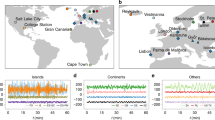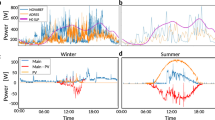Abstract
Multiple types of fluctuations impact the collective dynamics of power grids and thus challenge their robust operation. Fluctuations result from processes as different as dynamically changing demands, energy trading and an increasing share of renewable power feed-in. Here we analyse principles underlying the dynamics and statistics of power grid frequency fluctuations. Considering frequency time series for a range of power grids, including grids in North America, Japan and Europe, we find a strong deviation from Gaussianity best described as Lévy-stable and q-Gaussian distributions. We present a coarse framework to analytically characterize the impact of arbitrary noise distributions, as well as a superstatistical approach that systematically interprets heavy tails and skewed distributions. We identify energy trading as a substantial contribution to today’s frequency fluctuations and effective damping of the grid as a controlling factor enabling reduction of fluctuation risks, with enhanced effects for small power grids.
This is a preview of subscription content, access via your institution
Access options
Access Nature and 54 other Nature Portfolio journals
Get Nature+, our best-value online-access subscription
$29.99 / 30 days
cancel any time
Subscribe to this journal
Receive 12 digital issues and online access to articles
$119.00 per year
only $9.92 per issue
Buy this article
- Purchase on Springer Link
- Instant access to full article PDF
Prices may be subject to local taxes which are calculated during checkout







Similar content being viewed by others
References
Adoption of the Paris Agreement FCCC/CP/2015/L.9/Rev.1 (UNFCCC, 2015).
IPCC Climate Change 2014: Impacts, Adaptation and Vulnerability (eds Field, C. B. et al.) Part B (Cambridge University Press, Cambridge, 2014).
Jacobson, M. Z. & Delucchi, M. A. Providing all global energy with wind, water, and solar power, Part I: Technologies, energy resources, quantities and areas of infrastructure, and materials. Energy Policy 39, 1154–1169 (2011).
Schäfer, B., Matthiae, M., Timme, M. & Witthaut, D. Decentral smart grid control. New J. Phys. 17, 015002 (2015).
Turner, J. A. A realizable renewable energy future. Science 285, 687–689 (1999).
Boyle, G. Renewable Energy (Oxford University Press, Oxford, 2004).
Ueckerdt, F., Brecha, R. & Luderer, G. Analyzing major challenges of wind and solar variability in power systems. Renewable Energy 81, 1–10 (2015).
Heide, D. et al. Seasonal optimal mix of wind and solar power in a future, highly renewable Europe. Renewable Energy 35, 2483–2489 (2010).
Milan, P., Wächter, M. & Peinke, J. Turbulent character of wind energy. Phys. Rev. Lett. 110, 138701 (2013).
Peinke, J. et al. in Advances in Solid State Physics 363–373 (Springer, Berlin, 2004).
Machowski, J., Bialek, J. & Bumby, J. Power System Dynamics: Stability and Control (Wiley, Chichester, 2011).
Kundur, P., Balu, N. J. & Lauby, M. G. Power System Stability and Control 7 (McGraw-Hill, New York, 1994).
Ulbig, A., Borsche, T. S. & Andersson, G. Impact of low rotational inertia on power system stability and operation. IFAC Proc. Vol. 47, 7290–7297 (2014).
Delille, G., Francois, B. & Malarange, G. Dynamic frequency control support by energy storage to reduce the impact of wind and solar generation on isolated power system’s inertia. IEEE Trans. Sustain. Energy 3, 931–939 (2012).
Doherty, R. et al. An assessment of the impact of wind generation on system frequency control. IEEE Trans. Power Syst. 25, 452–460 (2010).
Wood, A. J. & Wollenberg, B. F. Power Generation, Operation, and Control (Wiley, 2012).
National Academies of Sciences Engineering and Medicine. The Power of Change: Innovation for Development and Deployment of Increasingly Clean Electric Power Technologies (National Academies Press, Washington DC, 2016).
Jin, Y. & Branke, J. Evolutionary optimization in uncertain environments—a survey. IEEE Trans. Evol. Comput. 9, 303–317 (2005).
Zhang, H. & Li, P. Probabilistic analysis for optimal power flow under uncertainty. IET Gener. Transm. Distrib. 4, 553–561 (2010).
Schäfer, B. et al. Escape routes, weak links, and desynchronization in fluctuation-driven networks. Phys. Rev. E 95, 060203 (2017).
Fang, X., Misra, S., Xue, G. & Yang, D. Smart Grids—the new and improved power grid: a survey. IEEE Commun. Surv. Tutor. 14, 944–980 (2012).
Kashima, K., Aoyama, H. & Ohta, Y. Modeling and linearization of systems under heavy-tailed stochastic noise with application to renewable energy assessment. In 2015 54th IEEE Conference on Decision and Control (CDC) 1852–1857 (IEEE, New York, 2015).
Mühlpfordt, T., Faulwasser, T. & Hagenmeyer, V. Solving stochastic AC power flow via polynomial chaos expansion. In 2016 IEEE Conference on Control Applications (CCA) 70–76 (IEEE, New York, 2016).
Anvari, M. et al. Short term fluctuations of wind and solar power systems. New J. Phys. 18, 063027 (2016).
Schmietendorf, K., Peinke, J. & Kamps, O. On the stability and quality of power grids subjected to intermittent feed-in. Preprint at https://arxiv.org/abs/1611.08235 (2016).
Li, X., Hui, D. & Lai, X. Battery energy storage station (BESS)-based smoothing control of photovoltaic (PV) and wind power generation fluctuations. IEEE Trans. Sust. Energy 4, 464–473 (2013).
Lauby, M. G., Bian, J. J., Ekisheva, S. & Varghese, M. Frequency response assessment of ERCOT and Québec interconnections. In 2014 North American Power Symposium (NAPS) 1–5 (IEEE, New York, 2014).
Lasseter, R. H. & Paigi, P. Microgrid: a conceptual solution. In 2004 IEEE 35th Annual Power Electronics Specialists Conference (PESC) vol. 6, 4285–4290 (IEEE, New York, 2004).
Network Frequency (2014–2016) (RTE, 2017); https://clients.rte-france.com/lang/an/visiteurs/vie/vie_frequence.jsp.
ENTSO-E Netzfrequenz (50Hertz, 2010–2016); http://www.50hertz.com/de/Maerkte/Regelenergie/Regelenergie-Downloadbereich.
Frequency Measurement Data (Fingrid, 2015–2016); http://www.fingrid.fi/en/powersystem/Power%20system%20management/Maintaining%20of%20balance%20between%20electricity%20consumption%20and%20production/Frequency%20measurement%20data/Pages/default.aspx.
Tchuisseu, E. B., Gomila, D., Brunner, D. & Colet, P. Effects of dynamic-demand-control appliances on the power grid frequency. Preprint at https://arxiv.org/abs/1704.01638 (2017).
Frequency Data (National Grid, 2014–2016); http://www2.nationalgrid.com/Enhanced-Frequency-Response.aspx.
Japanese Grid Frequency (OCCTO, 2016); http://occtonet.occto.or.jp/public/dfw/RP11/OCCTO/SD/LOGIN_login#.
FNET/GridEye (Power Information Technology Lab, University of Tennessee, Knoxville and Oak Ridge National Laboratory, 2014); http://powerit.utk.edu/fnet.html.
Samorodnitsky, G. & Taqqu, M. S. in Stable Non-Gaussian Processs: Stochastic Models with Infinite Variance (Chapman and Hall, New York, 1994).
Tsallis, C. Nonadditive entropy and nonextensive statistical mechanics—an overview after 20 years. Braz. J. Phys. 39, 337–356 (2009).
Gardiner, C. W. Handbook of Stochastic Methods. 3rd edn (Springer, Berlin, 1985).
Filatrella, G., Nielsen, A. H. & Pedersen, N. F. Analysis of a power grid using a Kuramoto-like model. Eur. Phys. J. B 61, 485–491 (2008).
Rohden, M., Sorge, A., Timme, M. & Witthaut, D. Self-organized synchronization in decentralized power grids. Phys. Rev. Lett. 109, 064101 (2012).
Dörfler, F., Chertkov, M. & Bullo, F. Synchronization in complex oscillator networks and smart grids. Proc. Natl Acad. Sci. USA 110, 2005–2010 (2013).
Motter, A. E., Myers, S. A., Anghel, M. & Nishikawa, T. Spontaneous synchrony in power-grid networks. Nat. Phys. 9, 191–197 (2013).
Manik, D. et al. Supply networks: instabilities without overload. Eur. Phys. J. Spec. Top. 223, 2527–2547 (2014).
Dewenter, T. & Hartmann, A. K. Large-deviation properties of resilience of power grids. New J. Phys. 17, 015005 (2015).
Weixelbraun, M., Renner, H., Schmaranz, R. & Marketz, M. Dynamic simulation of a 110-kV-network during grid restoration and in islanded operation. In 20th International Conference and Exhibition on Electricity Distribution-Part 1, 2009 1–4 (IET, Stevenage, 2009).
Carpaneto, E. & Chicco, G. Probabilistic characterisation of the aggregated residential load patterns. IET Gener. Transm. Distrib. 2, 373–382 (2008).
Soubdhan, T., Emilion, R. & Calif, R. Classification of daily solar radiation distributions using a mixture of Dirichlet distributions. Sol. Energy 83, 1056–1063 (2009).
Denisov, S., Horsthemke, W. & Hänggi, P. Generalized Fokker–Planck equation: derivation and exact solutions. Eur. Phys. J. B 68, 567–575 (2009).
Monthly Production for a Specific Year for 2015 (ENTSO-E, 2016); https://www.entsoe.eu/db-query/production/monthly-production-for-a-specific-year.
Eia-411: Coordinated Bulk Power Supply and Demand Program Report (US Department of Energy, 2016); https://www.eia.gov/electricity/data/eia411/.
Beck, C. & Cohen, E. G. D. Superstatistics. Physica A 322, 267–275 (2003).
Chechkin, A. V., Seno, F., Metzler, R. & Sokolov, I. M. Brownian yet non-gaussian diffusion: from superstatistics to subordination of diffusing diffusivities. Phys. Rev. X 7, 021002 (2017).
Clark, P. K. A subordinated stochastic process model with finite variance for speculative prices. Econometrica 41, 135–155 (1973).
Castaing, B., Gagne, Y. & Hopfinger, E. Velocity probability density functions of high Reynolds number turbulence. Physica D 46, 177–200 (1990).
Schöll, E. & Schuster, H. G. Handbook of Chaos Control (2008).
Acknowledgements
We gratefully acknowledge support from the Federal Ministry of Education and Research (BMBF grant no. 03SF0472A-F to M.T. and D.W.), the Helmholtz Association (via the joint initiative “Energy System 2050—a Contribution of the Research Field Energy” and grant no. VH-NG-1025 to D.W.), the Göttingen Graduate School for Neurosciences and Molecular Biosciences (DFG grant GSC 226/2) to B.S., the EPSRC via grant EP/N013492/1 to C.B., the JST CREST, grant nos JPMJCR14D2 and JPMJCR15K1, to K.A. and the Max Planck Society to M.T.
Author information
Authors and Affiliations
Contributions
B.S., D.W. and M.T. conceived and designed the research. B.S. acquired the data, performed the data analysis and formulated stochastic predictions. All authors contributed to discussing the results and writing the manuscript.
Corresponding author
Ethics declarations
Competing interests
The authors declare no competing financial interests.
Additional information
Publisher’s note: Springer Nature remains neutral with regard to jurisdictional claims in published maps and institutional affiliations.
Supplementary information
Supplementary Information
Supplementary Notes 1–6, Supplementary Tables 1–2, Supplementary Figures 1–16 and Supplementary References.
Rights and permissions
About this article
Cite this article
Schäfer, B., Beck, C., Aihara, K. et al. Non-Gaussian power grid frequency fluctuations characterized by Lévy-stable laws and superstatistics. Nat Energy 3, 119–126 (2018). https://doi.org/10.1038/s41560-017-0058-z
Received:
Accepted:
Published:
Issue Date:
DOI: https://doi.org/10.1038/s41560-017-0058-z
This article is cited by
-
Data-driven load profiles and the dynamics of residential electricity consumption
Nature Communications (2022)
-
Asymmetry underlies stability in power grids
Nature Communications (2021)
-
Statistical characterization of airplane delays
Scientific Reports (2021)
-
Fingerprints of nonequilibrium stationary distributions in dispersion relations
Scientific Reports (2021)
-
Network experiment demonstrates converse symmetry breaking
Nature Physics (2020)



